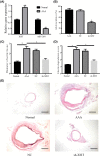XIST knockdown suppresses vascular smooth muscle cell proliferation and induces apoptosis by regulating miR-1264/WNT5A/β-catenin signaling in aneurysm
- PMID: 33501488
- PMCID: PMC7960886
- DOI: 10.1042/BSR20201810
XIST knockdown suppresses vascular smooth muscle cell proliferation and induces apoptosis by regulating miR-1264/WNT5A/β-catenin signaling in aneurysm
Abstract
Long non-coding RNAs (lncRNAs) have been ascertained as vital modulators in abdominal aortic aneurysm (AAA) development. In this research, the function and molecular mechanisms of the lncRNA X-inactive specific transcript (XIST) in the evolution of vascular smooth muscle cells (VSMCs) were assessed. Results showed that XIST expression was increased but miR-1264 expression level was reduced in the serum of AAA patients. XIST depletion impeded human aorta VSMCs (HA-VSMCs') ability to proliferate and stimulate apoptosis, while repressing miR-1264 expression through an unmediated interaction. Additionally, the influence of XIST knockdown on apoptosis and proliferation could be rescued by an miR-1264 inhibitor. Subsequent molecular investigations indicated that WNT5A was miR-1264's target, and XIST functioned as a competing endogenous RNA (ceRNA) of miR-1264 to raise WNT5A expression. Further, an miR-1264 inhibitor stimulated the proliferation and suppressed the apoptosis of HA-VSMCs through the activation of WNT/β-catenin signaling. Taken together, XIST impeded the apoptosis and stimulated the proliferation of HA-VSMCs via the WNT/β-catenin signaling pathway through miR-1264, demonstrating XIST's underlying role in AAA.
Keywords: abdominal aortic aneurysm; lncRNA; miR-1264; proliferation.
© 2021 The Author(s).
Conflict of interest statement
The authors declare that there are no competing interests associated with the manuscript.
Figures






Similar articles
-
Roles and Mechanisms of miRNAs in Abdominal Aortic Aneurysm: Signaling Pathways and Clinical Insights.Curr Atheroscler Rep. 2024 Jul;26(7):273-287. doi: 10.1007/s11883-024-01204-8. Epub 2024 May 6. Curr Atheroscler Rep. 2024. PMID: 38709435 Review.
-
Inhibition of XIST attenuates abdominal aortic aneurysm in mice by regulating apoptosis of vascular smooth muscle cells through miR-762/MAP2K4 axis.Microvasc Res. 2022 Mar;140:104299. doi: 10.1016/j.mvr.2021.104299. Epub 2021 Dec 21. Microvasc Res. 2022. PMID: 34942175
-
H19 knockdown suppresses proliferation and induces apoptosis by regulating miR-148b/WNT/β-catenin in ox-LDL -stimulated vascular smooth muscle cells.J Biomed Sci. 2018 Feb 7;25(1):11. doi: 10.1186/s12929-018-0418-4. J Biomed Sci. 2018. PMID: 29415742 Free PMC article.
-
Long Noncoding RNA XIST/miR-17/PTEN Axis Modulates the Proliferation and Apoptosis of Vascular Smooth Muscle Cells to Affect Stanford Type A Aortic Dissection.J Cardiovasc Pharmacol. 2020 Jul;76(1):53-62. doi: 10.1097/FJC.0000000000000835. J Cardiovasc Pharmacol. 2020. PMID: 32282501
-
Micro-RNAs in abdominal aortic aneurysms: insights from animal models and relevance to human disease.Cardiovasc Res. 2016 May 15;110(2):165-77. doi: 10.1093/cvr/cvw046. Epub 2016 Mar 10. Cardiovasc Res. 2016. PMID: 26965051 Review.
Cited by
-
Periostin Augments Vascular Smooth Muscle Cell Calcification via β-Catenin Signaling.Biomolecules. 2022 Aug 21;12(8):1157. doi: 10.3390/biom12081157. Biomolecules. 2022. PMID: 36009051 Free PMC article.
-
The role of long non-coding RNA in abdominal aortic aneurysm.Front Genet. 2023 Mar 15;14:1153899. doi: 10.3389/fgene.2023.1153899. eCollection 2023. Front Genet. 2023. PMID: 37007957 Free PMC article. Review.
-
Early Brain microRNA/mRNA Expression is Region-Specific After Neonatal Hypoxic-Ischemic Injury in a Mouse Model.Front Genet. 2022 Feb 16;13:841043. doi: 10.3389/fgene.2022.841043. eCollection 2022. Front Genet. 2022. PMID: 35251138 Free PMC article.
-
Roles and Mechanisms of miRNAs in Abdominal Aortic Aneurysm: Signaling Pathways and Clinical Insights.Curr Atheroscler Rep. 2024 Jul;26(7):273-287. doi: 10.1007/s11883-024-01204-8. Epub 2024 May 6. Curr Atheroscler Rep. 2024. PMID: 38709435 Review.
-
Transcriptome Sequencing Reveals Pathways Related to Proliferation and Differentiation of Shitou Goose Myoblasts.Animals (Basel). 2022 Oct 27;12(21):2956. doi: 10.3390/ani12212956. Animals (Basel). 2022. PMID: 36359079 Free PMC article.
References
MeSH terms
Substances
LinkOut - more resources
Full Text Sources
Other Literature Sources

